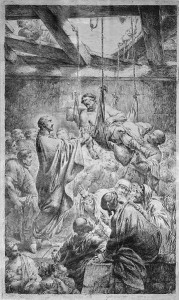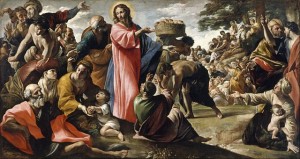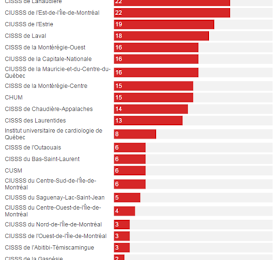 Richard Hays explores the ways in which the Gospel writers draw the Old Testament to narrate the identity of Jesus. In Reading Backwards: Figural Christology and the Fourfold Gospel Witness he focuses on Jesus as the embodiment of Israel’s God. In Echoes of Scripture in the Gospels he goes beyond this to look at other aspects of the identity of Jesus, as well as the re-narration of Israel’s story in light of Jesus and the role of the church (the gathering of Christ-followers) in the world. I am currently leading an adult education class at church based primarily on these books, especially Reading Backwards. This is an important topic for the church, especially in an academic community such as the one surrounding our church.
Richard Hays explores the ways in which the Gospel writers draw the Old Testament to narrate the identity of Jesus. In Reading Backwards: Figural Christology and the Fourfold Gospel Witness he focuses on Jesus as the embodiment of Israel’s God. In Echoes of Scripture in the Gospels he goes beyond this to look at other aspects of the identity of Jesus, as well as the re-narration of Israel’s story in light of Jesus and the role of the church (the gathering of Christ-followers) in the world. I am currently leading an adult education class at church based primarily on these books, especially Reading Backwards. This is an important topic for the church, especially in an academic community such as the one surrounding our church.
Jesus as The God of Israel? The first post How to Read the Bible focused on two passages in Mark involving Jesus commanding the wind and waves (4:35-41), and later walking on water (6:45-51). In the way both of these passages are presented by Mark we can see echoes of the Old Testament portrayal of God, Jesus does things that God does in Psalm 107 and Job 9. There are five other passages in Mark that Hays identifies as drawing on Scripture to portray Jesus as the embodiment of Israel’s God.
(1) The one for whom the way is prepared. Mark begins his Gospel (1:1-3):
The beginning of the good news about Jesus the Messiah, the Son of God, as it is written in Isaiah the prophet:
“I will send my messenger ahead of you,
who will prepare your way”—
“a voice of one calling in the wilderness,
‘Prepare the way for the Lord,
make straight paths for him.’”
The opening, calling Jesus the anointed one, is an echo of the Davidic kingship (Psalm 2) . The second title “Son of God” may be a later addition rather than original, but it is consistent with other passages in Mark (eg. 1:11 and 9:7) and is also most likely an echo of Jesus as the promised Davidic king. On the other hand, the quote from Isaiah clearly refers to the Lord himself, not his anointed one (40:3). The NIV has:
A voice of one calling:
“In the wilderness prepare
the way for the Lord;
make straight in the desert
a highway for our God.
Although Mark does not use the explicit quote, “him” in the last line clearly refers back to the Lord (kyrios) in the preceding line.
 (2) Forgiving sins. In 2:1-12 Mark relates the story of the healing of the paralytic man.
(2) Forgiving sins. In 2:1-12 Mark relates the story of the healing of the paralytic man.
When Jesus saw their faith, he said to the paralyzed man, “Son, your sins are forgiven.”
Now some teachers of the law were sitting there, thinking to themselves, “Why does this fellow talk like that? He’s blaspheming! Who can forgive sins but God alone?”
… [Jesus responded]
But I want you to know that the Son of Man has authority on earth to forgive sins.” So he said to the man, “I tell you, get up, take your mat and go home.” He got up, took his mat and walked out in full view of them all.
The complaint of the teachers of the law brings the point here. The Jewish teachers of the law knew that God alone forgives sin. While there is no proof text or direct quotation, the idea runs through the Old Testament. One example is in Exodus 34:6-7 “The Lord, the Lord, the compassionate and gracious God, slow to anger, abounding in love and faithfulness, maintaining love to thousands, and forgiving wickedness, rebellion and sin.” Jesus responds to the complaint of the teachers by demonstrating his power and healing the man.
 (3) The shepherd of Israel. The story of the Feeding of the Five Thousand begins in 6:34 “When Jesus landed and saw a large crowd, he had compassion on them, because they were like sheep without a shepherd. So he began teaching them many things.” Later (v. 39) Jesus directed the disciples to have the people sit down in groups on the green grass and he fed them. Sheep without a shepherd is, Hays suggests, an echo of Ezekiel 34 (along with other passages):
(3) The shepherd of Israel. The story of the Feeding of the Five Thousand begins in 6:34 “When Jesus landed and saw a large crowd, he had compassion on them, because they were like sheep without a shepherd. So he began teaching them many things.” Later (v. 39) Jesus directed the disciples to have the people sit down in groups on the green grass and he fed them. Sheep without a shepherd is, Hays suggests, an echo of Ezekiel 34 (along with other passages):
So they were scattered because there was no shepherd, and when they were scattered they became food for all the wild animals. My sheep wandered over all the mountains and on every high hill. They were scattered over the whole earth, and no one searched or looked for them. (5)
…
“‘For this is what the Sovereign Lord says: I myself will search for my sheep and look after them. As a shepherd looks after his scattered flock when he is with them, so will I look after my sheep. … I myself will tend my sheep and have them lie down, declares the Sovereign Lord. (11, 15)
…
I will save my flock, and they will no longer be plundered. I will judge between one sheep and another. I will place over them one shepherd, my servant David, and he will tend them; he will tend them and be their shepherd. I the Lord will be their God, and my servant David will be prince among them. I the Lord have spoken. (22-24)
Jesus is the shepherd who will lead the people. This is a role prophesied for the Davidic Messiah, but also a role assumed by God himself (and, of course, spoken of in Psalm 23). In this passage we see the identity of Jesus narrated as the shepherd of Israel.
 (4) The deaf will hear. The healing ministry of Jesus is another indication of his identity. In the story from chapter 2, above, we see the lame walk. In 7:31-37 a deaf, mute man hears and speaks, in 10:46-52 a blind man sees. In 7:31-37 in particular, Hays suggests an echo of Isaiah 35. It is even more clear in the Greek Septuagint then in modern English translations of the Hebrew and Aramaic Masoretic text.
(4) The deaf will hear. The healing ministry of Jesus is another indication of his identity. In the story from chapter 2, above, we see the lame walk. In 7:31-37 a deaf, mute man hears and speaks, in 10:46-52 a blind man sees. In 7:31-37 in particular, Hays suggests an echo of Isaiah 35. It is even more clear in the Greek Septuagint then in modern English translations of the Hebrew and Aramaic Masoretic text.
Then Jesus left the vicinity of Tyre and went through Sidon, down to the Sea of Galilee and into the region of the Decapolis. There some people brought to him a man who was deaf and could hardly talk, and they begged Jesus to place his hand on him.
After he took him aside, away from the crowd, Jesus put his fingers into the man’s ears. Then he spit and touched the man’s tongue. He looked up to heaven and with a deep sigh said to him, “Ephphatha!” (which means “Be opened!”). At this, the man’s ears were opened, his tongue was loosened and he began to speak plainly.
Jesus commanded them not to tell anyone. But the more he did so, the more they kept talking about it. People were overwhelmed with amazement. “He has done everything well,” they said. “He even makes the deaf hear and the mute speak.”
Isaiah 35:4-6a, 10:
Say to those who are of a fearful heart, “Be strong, do not fear! Here is your God. He will come with vengeance; with terrible recompense. He (himself) will come to save you.”
Then the eyes of the blind will be opened and the ears of the deaf shall hear; then the lame will leap like a deer, and the tongue of the stammerers will be clear.
…
and those the Lord has rescued will return. They will enter Zion with singing; everlasting joy will crown their heads. Gladness and joy will overtake them, and sorrow and sighing will flee away.
God opens the eyes of the blind and the ears of the deaf. The lame will leap and the stammerer who can hardly talk will speak clearly. Jesus enacts all of these in Mark, and two of them in this passage in chapter 7.
 (5) Wither the Fig tree. Mark 11:11-14; 20-22. Bracketing the incident overturning the tables of the money changers in the temple there is this curious tale of the fig tree. The incident seems rather bizarre standing on its own.
(5) Wither the Fig tree. Mark 11:11-14; 20-22. Bracketing the incident overturning the tables of the money changers in the temple there is this curious tale of the fig tree. The incident seems rather bizarre standing on its own.
On the following day, when they came from Bethany, he was hungry. Seeing in the distance a fig tree in leaf, he went to see whether perhaps he would find anything on it. When he came to it, he found nothing but leaves, for it was not the season for figs. He said to it, “May no one ever eat fruit from you again.” And his disciples heard it.
…
In the morning as they passed by, they saw the fig tree withered away to its roots. Then Peter remembered and said to him, “Rabbi, look! The fig tree that you cursed has withered.” Jesus answered them, “Have faith in God.
To make sense of this story we should turn to Jeremiah 8, a prophecy of sin and judgment, especially 8:13: “When I wanted to gather them, says the Lord, there are no grapes on the vine, nor figs on the fig tree; even the leaves are withered, and what I gave them has passed away from them.“
Hays comments:
It is God who is represented as seeking unsuccessfully to gather grapes and figs. What, then, are we to think when Mark tells the ominous and obviously symbolic story of Jesus’ fruitless search for figs on the fig tree, followed by the withering of the tree (Mark 11:12-14; 20-21)? What does this suggest about the identity of the one who searches for the fruit? This is yet another case where Jesus steps, at least functionally, into a role given exclusively to the Lord God in the Old Testament. (p. 76 Echoes)
Enacting a role taken on by Israel’s God. None of these passages alone is a knock-down proof that Mark intended his readers to see Jesus as the embodiment of Israel’s God. Taken together, however, they provide a powerful indication that Mark has and proclaims a high Christology. Hays concludes in Reading Backwards: “Our study of Mark suggests that Mark’s proclamatory mystagogy is meant to lead readers, through a mysteriously allusive reading of Israel’s Scripture, into recognizing Jesus as the embodiment of the God of Israel.” (p. 33) The term mystagogy comes from the Greek Orthodox tradition – where Mark is seen as one proclaiming the heavenly mystery.
Whether these examples can be taking as proclaiming the doctrine of the incarnation or not (and I find it highly suggestive), it is clear that Mark sees Jesus as enacting a role taken on by Israel’s God in the Old Testament. When we read the Gospels without the Old Testament in view, we often miss the point. The incident with the fig tree is a clear example.
There are other passages we could consider from the book of Mark that portray other aspects of the identity of Jesus. Hays runs through some of them in both books. These are the kinds of things that lead us to the doctrine that Jesus is fully human as well as divine. It is a mystery – and one that we should embrace.
Does Mark portray Jesus as, in some fashion, the embodiment of Israel’s God?
Do these echoes of the Old Testament enhance your understanding of Mark’s Gospel?
If you wish to contact me directly you may do so at rjs4mail[at]att.net
If interested you can subscribe to a full text feed of my posts at Musings on Science and Theology.




